|  | |||||
Polish armoured train Nr. 14 ("Paderewski")
Early history - Combat use in 1939 - Description
 |
| Armoured train Nr. 14 "Paderewski" in a camouflage from late 1930s (photographed in 1937). |
|  | |||||
Early history - Combat use in 1939 - Description
 |
| Armoured train Nr. 14 "Paderewski" in a camouflage from late 1930s (photographed in 1937). |
The armoured train Nr. 14, former "Paderewski", which bears origin from the train of this name fighting during the Polish-Bolshevik war in 1920, can be considered the most mysterious of Polish regular armoured train of 1939. The origin of its two twin-turret artillery wagons, believed to be Soviet designs, is in fact uncertain. For a long time after the war, the service of this train during 1939 September campaign was unknown. It was not until the beginning of the 21st century that the existence of photographs of the destroyed train was revealed, but they remain relatively rare, unlike other trains widely photographed by the Germans.
Note: links with dashed underline lead to Wikipedia articles.
The armoured train "Paderewski" was completed on 10 September 1919 in railway workshops in Lwów (now Lviv), as the third train built there (after P.P.3 "Lis-Kula" and P.P.10 "Pionier"). The train was commissioned as regular Armoured Train No. 15 (pociąg pancerny nr 15, often written in short as P.P. 15), after disbanded train P.P.15 "Groźny" (the first of this name). It was named during a ceremony in Warsaw, in a presence of its namesake, Polish prime minister Ignacy Paderewski, who gave the crew a commemorative gorget. The train's composition in the early years was variable. At first, it consisted mainly of improvised armoured rolling stock, converted from wooden freight box wagons. It could be noted, that the head of KBPP (Armoured Trains Construction Managment) in Lwów, responsible for armoured train designing, was professor mathematician Kazimierz Bartel, later prime minister.
Ignacy Paderewski (1860-1941) was Polish pianist of international fame, composer and politician (Prime Minister in 1919-1920), considered as one of the fathers of Poland's independence.
The train was initially composed of one armoured locomotive, six armoured wagons and two flatcars. According to K. Margasiński, among the wagons there were two artillery wagons, a machine gun wagon, an assault platoon wagon, a kitchen wagon and an ambulance wagon. Presumably both artillery wagons were the same, of more advanced design comparing to earlier trains, with a rotating cannon at one end, protected with steel plates forming a turret, with an arc of fire around 270°. Their walls were also covered with steel plates (probably not of armour steel though). Their design was further development of "Pionier" wagons, and a barbette shape reveals an inspiration from captured Austrian wagons. An armament was Austrian fortress cannon 8 cm (76.5 mm) Kasemattkanone M.94 or M.95. The rest of the stock were wooden freight box wagons, most probably protected with a concrete from inside, fitted with loopholes for heavy machine guns and rifles. The train was then fitted with the second locomotive and the third artillery wagon – wooden one, with similar cannon in one side wall.
The engines were Austrian 178 class tank locomotives, armoured in Lwów with 10-15 mm plates, numbers: 178.95 and 178.111. In November 1919 the documents indicate, that the train had also the third locomotive 229 class (229.1). Thanks to two or three locomotives, a part of the train could have been detached for patrolling, liaison of securing bridges behind the train. Apart from the combat section (A), the train had an auxiliary section (B), consisting of 20 wagons and semi-armoured locomotive.
 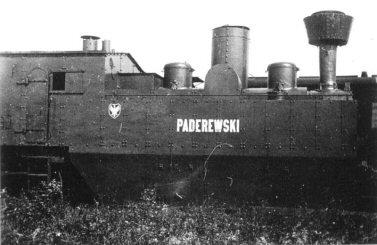 |
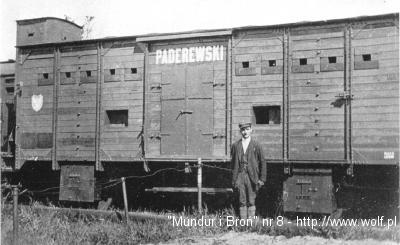 |
| Early locomotives series 178, armoured in Lwów, used in "Paderewski" – on the left 178.95, on the right probably 178.111. Noteworthy are different styles of the train's name and positions of Polish Eagle coat of arms (the locomotive on the left probably has an overpainted name). | Early improvised assault wagon of "Paderewski", with a brakesman booth, fitted with loopholes for machine guns and rifles, 17 September 1919. [5] |
"Paderewski" entered action on 29 September 1919. Its commander until March 1920 was Lt. Włodzimierz Abłamowicz, then Lt. Jan Lissan; his deputy was Lt. Rojewski. The train was first directed to South-West Front to patrol Polish-German border until 15 October 1919, on Częstochowa - Herby line, after the 1st Silesian Uprising. Then it was sent to north-east to patrol Polish-Lithuanian demarcation line west of Wilno (Vilnius). On 18 January 1920 it repelled attacks of Lithuanian forces from Oława (Alove) and Mieluny during border incidents. On unknown date its wooden artillery wagon with a side cannon was replaced with new steel artillery wagon with a central turret upon a roof, with 8 cm Austrian cannon (it was built in Nowy Sącz upon Austrian flatcar Jke 673 023 with a brakesman booth, later rebuilt to assault wagon 631 550 and used in 1939 in armoured train Nr. 54 "Groźny"). The train's wagons were then fitted with universal axles developed by engineer Adam Marie from Lviv KBPP, enabling to change their gauge. The train next operated in Polesie region in Belorussia, in Polesie Group (Grupa Poleska) of the Lithuanian-Belarussian Front.
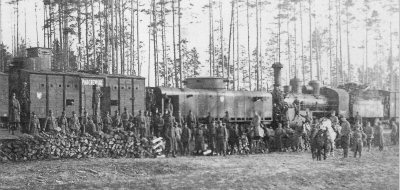 |
| "Paderewski" in March 1920, with a broad-gauge O class locomotive and newer artillery wagon with a central turret (later rebuilt to an assault wagon, used in Nr.54 "Groźny" train). Its significant feature was a construction of 11 vertical armour strips. |
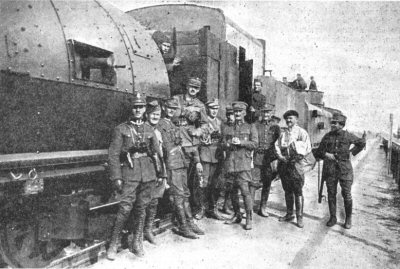 |
| "Paderewski" in Mińsk Mazowiecki, August 1920, with the new stock. On the left is an assault wagon built in Warsaw, armed with 7.92 mm MG-08 MGs. The train has an armoured tank locomotive 229 class. On the right, the artillery wagon with a central turret. |
 |
| "Paderewski" in early 1920s, with new ex-Soviet twin-turret artillery wagon. On the left there is apparently one of its original artillery wagons. The locomotive is 229 class. |
In March 1920 the train was moved to freshly captured Kalinkavichy near Mazyr. On 23 March 1920 it was converted there to broad gauge 1524 mm, to support Polish units farther east during Kiev offensive. It received captured Soviet locomotive O class then (the photograph indicates, that it was only partially armoured – drivers' cab, engines). It operated in area of Vasilevichy and Rechytsa, and supported Polish infantry among others at Shacilki (now Svietlahorsk). On 2 May it was rearmed with captured Russian 76.2 mm cannons because of their greater range and better ammunition availability. From 9 May the train stayed in liberated Kiev, from 17 May in Kozyatyn. Then it patrolled and fought in Bila Tserkva area.
In June and July 1920, the train had to cover Polish retreat. It operated on Kiev – Vasylkov line, then it was moved to Korosten. On 4 July, threatened with cutting-off, it managed to withdraw north from Zdolbunov through Rovne to Sarny. In next days it was converted to normal gauge in Luninets. In mid-July it was withdrawn to Warsaw in central Poland, and then fitted with one or more new half-barrel armoured wagons of Warsaw KBPP construction, more advanced, than the initial ones, built of steel plates and rounded stripes (more on this type on "Bartosz Glowacki" page). "Paderewski" got at least one assault wagon of such type (identified by a presence of rifle loopholes). The locomotive was now Austrian 229 class tank locomotive 229.42, with standard Polish armour. According to some publications, the "Paderewski" had three artillery wagons and two assault wagons then[4]. In addition to the wagon with a central turret, it probably still had one or both original artillery wagons.
In August 1920, "Paderewski" fought in the battle of Warsaw within Polish 1st Army's armoured train unit (along with trains "Danuta" and "Mściciel"). It operated first in an area around Wołomin. On 14 August it performed a raid from Wołomin along with the "Mściciel" on the second track, to disperse enemy units. On 16 August after midnight both trains supported 47th Infantry Regiment repelling an attack near Wołomin. A Soviet commander reported on a combat at Leśniakowizna village: "...despite falling darkness, armoured trains were still running on the line, causing losses to Red artillery regiments, without any break". On 17 August 1920 the three armoured trains took part in a surprise attack to capture Mińsk Mazowiecki, in cooperation with cavalry and tanks. The group's commander Maj. Mieczysław S. Nowicki was in "Paderewski". On 18 August the train patrolled and fought against Soviet unit numbering 860 men, who surrendered. After that, "Paderewski" was assigned to the 5th Army, with Maj. Nowicki's group, operating from 20 August on Ciechanów – Mława direction. Then it was assigned to the 2nd Army, in which it fought in the battle of the Niemen river 20-29 September.
After Polish-Soviet war, in October 1920 the "Paderewski" was used in an offensive to capture Lithuanian city of Wilno (Vilnius). Officially it was a self-willed action of Gen. Lucjan Żeligowski's task force ("Żeligowski's mutiny"), though in fact he was inspired by the Polish authorities to capture this Polish-inhabited city. As a result, a puppet state Central Lithuania was created under Polish protectorate for some time. It was incorporated into Poland a year later. In order to delude Inter-Allied Committee, on 20 October 1920 the "mutinied" train was renamed to: "General Żeligowski", and then officially served in armed forces of Central Lithuania. In August 1921 it was renamed back. It is not clear when it returned formally to Polish Army. It might have consisted in that period of one original artillery wagon, the wagon with a central turret, and a four-axle twin-turret artillery wagon with one 76.2 mm gun and one 122 mm howitzer, captured from Soviet train BP 56 "Kommunar" (it was used during Polish-Soviet war in PP.19 "Podhalanin-szeroki", disbanded after the war, and from 1930 until 1939 in armoured train Nr. 54 "Groźny"). As the photograph shows, it belonged to "Paderewski" along with its earlier stock, but it is not known since when - possibly only from 1921.
This chapter was created with a help of Krzysztof Margasiński.
After the war, in 1921, the "Paderewski" was assigned for further service, among 12 best equipped trains, grouped in six squadrons. It temporarilly bore a number 7 (P.P. 7). In winter of 1923/24, most of Polish armoured trains, including "Paderewski", were demobilized and stored. It was assigned number P.P. 3 then. In case of mobilization, it was supposed to create the Armoured Train Detachment II, along with the train P.P. 4 "Śmierć", based in Legionowo near Warsaw (sometimes quoted as nearby Jabłonna). In 1925 however "Paderewski" was brought back to service and assigned to newly created peacetime Armoured Trains' Training Detachment in Legionowo (already consisting of "Danuta" and "Generał Sosnkowski"). In October 1927 the Training Detachment was reformed to the 1st Armoured Train Detachment (1 dywizjon pociągów pancernych), grouping six, then five armoured trains.
 |
| The training train in mid-1920s – from the left: a flatcar, ex-Soviet artillery wagon of "Paderewski" (finally of "Groźny"), and type I artillery wagon and Warsaw type assault wagon from "General Sosnkowski". The locomotive is Ti3-12 from "Paderewski" with early armour type. |
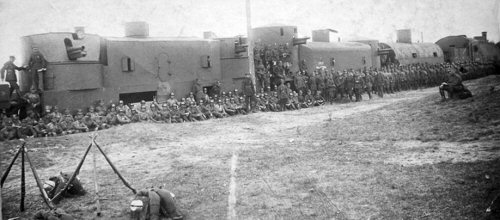 |
| The training train in summer of 1925, the composition as above. |
It should be kept in mind, that in 1920s and 1930s Polish trains underwent several reorganizations, and their stock was being swapped and renumbered. The documents are incomplete and the details are only partially known, thanks mostly to recent research by Adam Jońca and Arthur Przeczek. There still remains some error risk however. According to newest research, in 1925 "Paderewski" consisted of:
As the photographs show, from mid-1920s training trains were often set up of the stock of all three armoured trains of Training Detachment ("Generał Sosnkowski", "Danuta" and "Paderewski"). Unfortunately, there are not known any photographs of the second "Paderewski's" artillery wagon from that period.
In January 1930 the final composition of Polish armoured trains was established, with later minor changes. The wagon with later number 450 012 was given to the 2nd Armoured Train Detachment, to the train "Groźny", which already had the second wagon of such type. The "Paderewski" was equipped with two twin-turret four-axle artillery wagons, nos. 402 634 and 660 601, which it retained until World War II. Their origin is however not sure (see below). It is known from documents, that these wagons underwent two major refits and number changes, what makes establishment of their origin more difficult. The wagon 660 601 might have been the one already used, and might have been of Soviet origin indeed, but it was next fitted with new shorter American flatcar chassis. The other wagon was probably rebuilt from Polish twin-turret wagon of "Stefan Czarniecki" train and seated upon the same chassis.
The train was also given an assault wagon 425 627, but before 1939 it was given to the train "Danuta", and "Paderewski" finally received smaller wagon 430 044 from the "Poznańczyk". The locomotive Ti3-12 was changed to Ti3-8 with the standard armour. By the early 1930s the train's armament was standardized (100 mm wz.14/19P howitzers, 75 mm wz.02/26 guns and wz.08 MGs) and AA machine guns were added. The train also received radio and signal equipment then, and Westinghouse brakes. It seems, that in 1930s the stock of "Paderewski" was in a reserve, apart from the locomotive Ti3-8, whish was used with training trains.
In August-September 1939, during the mobilization, the 1st Armoured Train Detachment mobilized five trains, and among them armoured train Nr. 14 - former "Paderewski" (the names were not used anymore officially). It was mobilized in the first wave of general mobilization, with readiness time +3 days.
| 1919 | 1920 | 1921 | 1922 | 1923 | 1924 | 1925 | 1926 | 1927 | 1928 | 1929 | 1930 | 1931 | 1932 | 1933 | 1934 | 1935 | 1936 | 1937 | 1938 | 1939 | ||
| 2-axle, frontal turret (1) |  | ? | ||||||||||||||||||||
| 2-axle, frontal turret (2) |  | |||||||||||||||||||||
| 2-axle, side gun |  | ? | ||||||||||||||||||||
| 2-axle, central turret |  | ? | ? | to "Groźny" as assault wagon 631 550 | ||||||||||||||||||
| 4-axle, twin-turret |  | ? | to "Groźny" as 450 012 | |||||||||||||||||||
| 4-axle, twin-turret |  | ? | ? | (initial look different) | 660 601, later 650 980 or 660 588 | |||||||||||||||||
| 4-axle, twin-turret |  | 402 634, later 658 681 or 658 641 | ||||||||||||||||||||
| Assault wagons: | ||||||||||||||||||||||
| 2-axle, wooden (several) |  | |||||||||||||||||||||
| 2-axle, Warsaw type |  | ? | ? | ? | ||||||||||||||||||
| 2-axle 425 627 |  | ? | ? | ? | ? | to "Danuta" | ||||||||||||||||
| 2-axle 430 044 |  | ? | ? | ? | ? | |||||||||||||||||

(map)
Armoured train nr. 14 was initially assigned to the Polish C-in-C reserve. Its commander was initially Cpt. Jerzy Żelechowski, substituted during a campaign by a deputy Cpt. Henryk Gawełczyk.
 |
| One of rare photographs showing the train Nr.14 thoroughly destroyed by the crew. An assault wagon was between Ti3-8 locomotive and rear artillery wagon... |
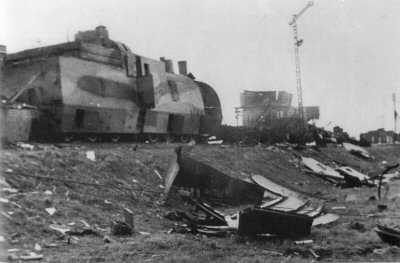 |
Up to 4 September 1939 the train was still being mobilized in Legionowo. On 1 September, after the war's outbreak, it was assigned to the Army "Pomorze" (Pomerania). On 6 September the train went to Kutno, where it remained without combat orders for almost week, evading bombing raids on the station. The commander was replaced by Cpt. Gawełczyk in that period.
The first - and last battle of "Paderewski" was the battle of the Bzura river – the Polish counteroffensive attempt, resulting in the biggest battle of the campaign. Along with armoured train Nr. 11 ("Danuta"), on 12 September it was assigned to an operational group of of Gen. Mikołaj Bołtuć. On 13 September it was ordered to move near Łęczyca to support a cavalry operational group of Gen. S. Grzmot-Skotnicki.
The train Nr 14 came into action on 14 September supporting Polish Border Guards battalion, which was halting attacks of German 221st Inf.Div. near Łęczyca until night. It was duelling with German 221 Infantry Division's artillery and co-operating with the 11th Mounted Artillery Detachment of the Pomorska Cavalry Brigade. At night the train returned to Kutno, then it operated on a line Kutno Łowicz until its end (a satellite photo of an operation area). On 16 September at noon, while at Rząśno, its artillery supported a counterattack of the 2nd battalion of the 70th Infantry Regiment of Grzmot-Skotnicki's group, halting an advance of German 44th Regiment (10th Inf. Div.) south of the line, in an area of Sobota. In the afternoon it was attacked by aircraft at nearby Jackowice station, without results – possibly only with machine guns. Later, when the Polish forces had to withdraw towards the Słudwia river, the train could not withdraw eastwards due to track damage near Łowicz and had to be abandoned. The crew blew up the train between Rząśno and Jackowice and joined infantry units, trying to break towards Warsaw. Our analysis of photographs suggests, that it was destroyed near position 52°09'41,5" N 19°46'33,5" E. It should be noted, that Nr. 11 armoured train was abandoned in a similar place and time. "Paderewski's" stock was destroyed beyond repair – of the assault wagon and artillery wagon 660 588 only chassis remained – and was not utilized by the Germans. One draisine R with FT tank was blown up as well; the fate of other draisines is not known.
It could be noted, that for many years the train's fate was unclear in publications, and older ones suggested, that it had been destroyed by aircraft. Only in the 21st century German photos of the blown-up train were revealed.
 |  |
| Interesting aerial photograph of a blown-up train Nr. 14. | Visible wagon nr. 658 641 and modified flatcar |

The armoured train nr. 14 ("Paderewski") consisted of:

| flatcar | artillery wagon | armoured locomotive | assault wagon | artillery wagon (2) | flatcar (2) |
The armoured train, as a military unit, consisted of: an armoured section, a platoon of armoured draisines and an unarmoured auxiliary section. The armoured section and armoured draisines were the combat section of the armoured train, while the auxiliary section was supporting the operation of the combat section in respect of logistics and accommodation, and did not take part in combat, staying at the rear.
From around 1936, combat rolling stock was painted in standard three-color camouflage of Polish vehicles, consisting of irregular dark brown and olive green patches, airbrushed upon a greyish sand basic color. The patches were oblong, mainly horizontal. Earlier – from early 1930s, there was used a scheme of three unknown colours (probably dark yellow, olive green and light blue gray, like in armoured vehicles), separated with black lines. There is not known a camouflage in 1920s – probably they were in an uniform colour, possibly gray.
The crew of the train's armoured section was about 120-130 men – the whole armoured train's crew in 1939 (with an auxiliary section and draisines) was 191, including 9 officers.
 |
| Ti3-8 locomotive of the "Paderewski" in late camouflage. |
The standard locomotive of Polish armoured trains in 1939 was armoured steam locomotive PKP Ti3 class – former Prussian G5³ class, manufactured between 1903 and 1906 and armoured in Poland. From early 1930s "Paderewski" used locomotive Ti3-8, former G53-4114 Halle, built in 1904 by Henschel, factory number 6555. According to some sources, it had standard three-axle tender 12C1 number 479. During peacetime, this locomotive was also used with other trains in the 1st Armoured Train Unit – noteworthy is, that it was used during official "photo session" of trains: "Paderewski", "Generał Sosnkowski" and "Śmierć" around 1937 (thanks to it, both sides are known).
"Paderewski" used Ti3 locomotives from around 1923 – initially it was Ti3-12 (ex G53-4021 Münster) with early non-standard armour. Later it was fitted with standard armour and given to armoured train "Danuta".
Upon a tender, there was a commander's turret. From the outbreak of 1920s and 1930s it was equipped with a short-range radio RKB/C to contact the draisines, and an intercom to contact the wagons. It also had optical and sonic means of internal communication (color lights, bells and horns). Maximum speed of the locomotive with armoured wagons was about 45 km/h (28 mph). The armoured part was equipped with Westinghouse brakes by 1930s.
According to A. Jońca, Ti3-8 locomotive was repaired and used by Wehrmacht afterwards.
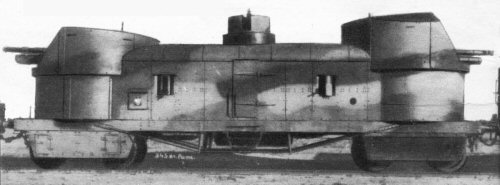 |
|
|---|
"Paderewski" in its last incarnation had two twin-turret artillery wagons, armed with 75 mm cannon and 100 mm howitzer each. They were superficially similar, seated on the same four-axle chassis, but were of different type, what is evident among others in walls' construction. Older publications claimed, that they were of Soviet origin, but it is not confirmed. There are not known photos of Soviet trains with such exact wagons. On the other hand it is known, that they were rebuilt twice in Poland, what surely changed their appearance. Probably it was unique Polish production, using parts of old wagons, including captured ones. The body of wagon 660 588 might have originated from the captured Soviet wagon, probably used in "Paderewski" in 1925, but it must have been shortened, when seated upon the new chassis. On the other hand, wagon 658 641 was probably a rebuilt two-axle wagon nr 658 126 from Polish train "Stefan Czarniecki", which had a similar cylindrical turret at one end, but the second turret of bigger diameter on the roof. In 1933, according to A. Jońca, both wagons were fitted with the same four-axle chassis of US flatcars with Diamond type bogies, with frame length 11.44 m and span between bogie pivots 8 m. Their look before 1933 is unfortunately not known. According to sources, these wagons were renumbered twice (initially for the wagon with higher turrets in 1930 number 660 601, then 650 980 and after 1933: 660 588, and for the wagon with cylindrical turrets initially 402 634, then 658 681 and after 1933: 658 641 – however, errors in reports can't be excluded, especially in case of numbers differing with one digit. There is also number 690 601 quoted in publications for 660 601 wagon, possibly erroneous.
Each wagon was armed with one 100 mm wz. 14/19A howitzer (Austro-Hungarian Skoda) and one 75 mm wz. 02/26 field gun (modified 3in Putilov). Their horizontal angle of fire was about 240-270°. There is no closer data on this peculiar train, but some 100-125 artillery rounds per gun were carried in artillery wagons. A further armament were four 7.92 mm wz. 08 (Maxim MG-08) heavy machine guns in drum moutings in sides. The wagon nr. 660 588 had additional four 7.92 mm wz. 08 machine guns in artillery turrets, on either side of guns. In early 1930s, each of the artillery wagons was fitted with one 7.92mm wz. 08 anti-aircraft machine gun in a small turret on the roof, with maximum elevation of 90°. The ammunition was probably 3,750 per each MG (in 15 x 250-round belts). . An initial armament of wagons most likely consisted of 76.2mm wz.02 guns (3in M.02 Putilov).
 |
|
|---|
There is no information on armour thickness of these wagons specifically. Probably it was made of boiler steel 10-20 mm thick (newer Polish wagons even had two-layer armour). If bodies of these wagons were ex-Soviet, they could have been made of armour steel, some 8-12 mm thick. Probably they were also covered with oak planks from the inside. Both wagons had one big central entrance hatch on each side, and hatches in bottoms. The wagon's crew was around 35 men.
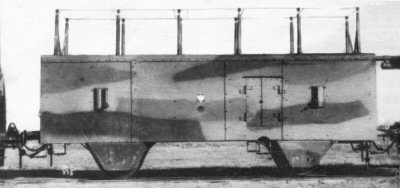
A two-axle assault wagon (Polish nomenclature) was intended for a transportation of an assault platoon. The wagon of "Paderewski", number 430 044, was converted from a steel artillery wagon (with a roof turret) of the train "Stefan Czarniecki", built in Poland on a chassis of the Prussian open wagon. Initially this wagon was assigned in 1930 to "Poznańczyk" armoured train, finally (before 1937) to "Paderewski". Its armament consisted of four 7.92mm wz. 08 machine guns in drum mountings in the sides. The ammunition was probably 3,750 per MG (in 250-round belts). The armour was similar to artillery wagons, the body was built of big flat steel plates. The assault platoon consisted of 32 men (1 officer, 7 NCO's, 24 soldiers, with 2 LMG's). The total wagon's crew was about 40 (with signalmen and stretcher-bearers).
By 1930s, the assault wagon was equipped with Polish long-range radio RKD/P, placed in a separate radio cab in the middle of the wagon. The radio had maximum range 50–80 km with telegraphy (probably below 20 km with voice transmission). The wagon was also fitted with a power generator, batteries, and a large clothesline aerial on the roof (six masts in two rows). The wagon had an entrance hatch in each side, and possibly also hatches in the bottom.
On both ends of the armoured section there were two two-axle flatcars. Their primary function was to carry engineering materials for track repairing (tools, rails and sleepers, logs, explosives, etc). The second purpose was to protect the train against mines or a derailment. There could also be carried eg. bicycles and scout motorcycles (part of them was carried on the auxiliary train's flatcars). During march, there could be an observer upon the flatcar, operating braking valve.
The standard flatcar was series Pdkz, type C VIII (described also as Pdks series). Its weight was about 10 t, load capacity – 17.5 t, frame length – 13 m, wheelbase – 8 m. Special flatcars for armoured trains were modified by fitting three full-width boxes for tools underneath a chassis and 22 lockers for small parts in the chassis, but there were not enough of them, and Nr.14 train had only one modified flatcar and the second standard one, delivered by the Polish State Railways (PKP) during the mobilization.
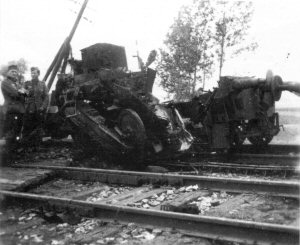 |
| Remains of blown up R draisine of Nr.14 train. It was coupled to the flacar on the right. |
Each armoured train, mobilized in 1939, had a platoon of armoured draisines (scout rail vehicles). Train nr. 14 had a standard armoured draisines platoon, consisting of:
- two R type armoured draisine (FT-17 tanks on rail chassis)
- four TK type armoured draisines (TKS tankettes on rail runners)
Draisines usually acted in two units, consisting of one R and two TK draisines. All the tanks could be easily detached from their rail chassis' and then used for ground reconnaissance tasks. The fifth TKS tankette was a reserve one. See the details on armoured draisines page.
Each armoured train, considered as a military unit, also included an unarmoured auxiliary section. The auxiliary section accompanied the combat section in operational movements and provided it with an accommodation and logistics support. It was manned by a platoon consisting of 1 officer, 21 NCOs and 26 soldiers. The length of the auxiliary section of the train was about 250 m (820 ft).
The auxiliary train consisted of: a locomotive, coaches for officers (2), wagons for NCOs (2) and soldiers (8), bureau wagon, ammunition wagons (2), fuel store wagon, technical store wagon, ambulance wagon, kitchen wagon, workshop wagon, open coal wagon, water tanker and flatcars (5) - some 27 carriages in all[2]. According to other sources there were only 3 flatcars, but also non-regulation food store wagon and sometimes guard wagon. The coaches were three-axle Dy series, the wagons were by default two-axle adapted boxcars Kd series.
The auxiliary train also should have two wz.34 half-tracked trucks, one truck and four heavy motorcycles with sidecars CWS M-111 – carried upon three flatcars, although actual composition differed and might have contained other cars, like Polski FIAT 508/III field cars and pick-ups. Typical Polish truck was 2.5t Polski FIAT 621L (4x2). Wz.34 half-tracks were in the repair patrol, and they could be equipped with a rail-riding device, although they seem rather rare.
All corrections and additional information or pictures are welcome
Sources:
1. Janusz Magnuski: Pociag pancerny "Danuta", Typy Broni i Uzbrojenia (TBiU) No.18; Wydawnictwa MON; Warsaw 1972
2. Rajmund Szubański: Polska broń pancerna 1939; Warsaw 1989
3a. Paul Malmassari: Les Trains Blindes 1826 - 1989; Editions Heimdal, 1989
3b. Paul Malmassari: Armoured Trains: An Illustrated Encyclopedia 1825-2016; 2016
4. Pociagi pancerne 1918-1943, Białystok 1999
5. "Mundur i Broń" nr 8
6. Józef Jurczyk, Krzysztof Margasiński: Dziennik pociągu pancernego Hallerczyk, Czechowice-Dziedzice - Częstochowa 2010
7. Marian Żebrowski: Zarys historii polskiej broni pancernej, Londyn 1971
8. Janusz Magnuski: 50 lat wrzesnia - Broń pancerna in: "Wojskowy Przegląd Techniczny", nr 9/1989
9. Adam Jońca: Pociągi pancerne z Legionowa in: Do Broni! nr specjalny 2/2009
10. Adam Jońca: Pociągi pancerne z Legionowa, Wielki Leksykon Uzbrojenia Wrzesień 1939 tom 24, Warsaw: Edipresse Polska, 2013
11. Adam Jacek Ostrówka: Pociągi pancerne Wojska Polskiego 1918-1939, Toruń 2004
12. Tadeusz Krawczak, Janusz Odziemkowski: Polskie pociągi pancerne w wojnie obronnej Polski 1939r.; in: Wojskowy Przegląd Historyczny nr 100, 1982.
13. Janusz Ledwoch: Polskie pociągi pancerne 1939, Tank Power vol. CXLVIII (407); Warsaw: Militaria, 2014
14. Adam Jońca: Polskie Pociągi Pancerne 1921-1939, Warsaw: Vesper, 2020
Update history:
[ Main page » Polish armour » armoured trains ]
[ Polish artillery ] [ Steel Panthers page ] [ Links ] 
You can mail me with questions or comments.
All photos and pictures remain the property of their owners. They are published in non-commercial educational and research purpose.
Text copyright to Michal Derela © 2000-2020.